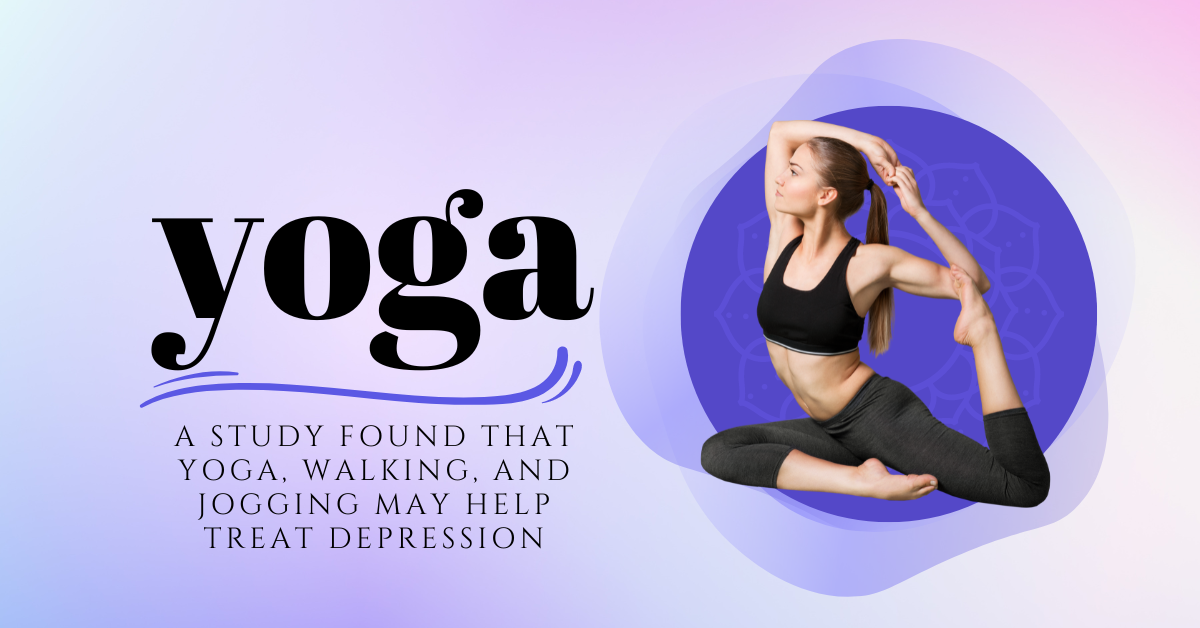A study found that yoga, walking, and jogging may help treat depression. A recent review of more than 200 studies reveals that exercise can be just as beneficial as therapy in treating depression.
The study, published in The BMJ, discovered that walking, jogging, yoga, and strength training are most effective at reducing depressive symptoms, particularly when the workouts are more intense.1
Approximately 18 million adults in the United States report having ever been diagnosed with depression.2 Medication and psychotherapy can be effective treatments for depression, but not everyone seeks or has access to them. While clinical guidelines in the United States and other countries encourage exercise to supplement these treatments, the authors observed that these recommendations are inconsistent and unclear.1
The researchers stated that the study’s findings could serve as a platform for future guidelines.
“We discovered that exercise reduces depression at levels comparable to gold-standard treatments such as cognitive-behavioural therapy,” Michael Noetel, PhD, lead study author and senior lecturer in psychology at the University of Queensland in Australia, told Health.
Exercises with the Biggest Impact on Depression
Researchers examined data from 218 studies including over 14,000 people that evaluated the relationship between depression and exercise. The exercises examined included walking, jogging, yoga, weight training, tai chi, and qigong.
Noetel M., Sanders T., Gallardo-Gómez D., et al. Effect of exercise on depression: a comprehensive review and network meta-analysis of randomized controlled trials. BMJ, 2024;384:e075847. doi:10.1136/bmj-2023-075847.
The team discovered that all of the exercises were “well tolerated” and beneficial, either on their own or in combination with therapy and drugs. However, walking, jogging, yoga, and strength training provided the greatest advantages, with running and interval training being the most effective.
The researchers discovered that strength training benefited women more than men, although yoga and qigong had a greater impact on males.
Nortel believes the discrepancies could be attributed to the novelty of the activities for the specific group. “A big part of treatment for anxiety is breaking harmful cycles that keep us stuck,” I heard him say.
The researchers also discovered that more strenuous exercise had a higher influence on mood, regardless of workout duration. However, lower-intensity exercise produced improvement.
The authors acknowledged the study’s limitations, such as the limited number of participants in the publications it examined and the possibility of bias in many of them.
What Causes Exercise’s Effect on Depression?
Nortel stated that experts do not know exactly how exercise relieves sadness, but one way it does is by altering the balance of neurotransmitters in the brain.
Ulrick Vieux, DO, a sports psychiatry specialist at Hackensack University Medical Center, told Health that exercise produces dopamine and serotonin, which regulate mood. “Low levels of serotonin in for instance, have been linked to…depression, anxiety, obsessive- compulsive disorder, and phobias,” he told me.”[But] exercise raises serotonin levels.”
Vieux noticed that exercise, in addition to bodily changes, can provide a sense of accomplishment and personal control.
Brent Nelson, MD, an adult interventional psychiatrist and Prairie Care’s chief medical information officer, told Health that exercise is also linked to improved sleep, social contact, and mindfulness, which can help with depression.
Finding the Ideal Workout.
Rachel Goldberg, LMFT, a therapist, personal trainer, and fitness instructor at Rachel Goldberg Therapy. Told Health that the best exercise for persons suffering from depression is based on their existing routine.
While changing up an exercise program can assist experienced exercisers. Non-exercisers may see an improvement in their symptoms once they begin working out.
To find motivation, Nelson recommends setting specific goals, seeking support from loved ones. Participating in group exercises, tracking and rewarding progress, and selecting convenient and enjoyable exercises.
Noetel emphasized that persons with depression may benefit. The most from an exercise regimen that will “push you, at least a little.” Still, Vieux underscored consulting with a healthcare physician before modifying or beginning an exercise routine. A medical professional can help you develop a safe, that’slpful routine.
Yoga is a holistic discipline from ancient India that integrates physical postures (asanas), breath control (pranayama), relaxation techniques, and meditation. It aims to improve physical, mental, and spiritual Health. Here’s a summary of the important features:
Asanas (Postures) are physical postures used to stretch, strengthen, and balance the body. Each position offers distinct advantages for various body regions and overall Health.
Pranayama (Breath Control):
A series of breathing exercises that increase breath awareness and control. It helps to soothe the mind, increase vigor, and improve overall health.
Meditation is a technique used in yoga to focus. The mind and achieve a deep sensation of relaxation and inner calm. It can be performed in various ways, including mindfulness meditation and guided visualization.
Relaxation techniques include deep breathing, progressive muscular relaxation, and yoga nidra.
Yoga is founded on philosophical ideas emphasizing ethical rules (yamas and niyamas), self-control, and self-awareness.
Benefits: Regular yoga improves flexibility, strength, posture, balance, and cardiovascular Health. It also alleviates stress, anxiety, and depression while improving mental clarity and well-being.
Yoga is adaptable to all fitness levels and health issues, making it suitable for people of all ages and backgrounds. It is frequently practiced in classes given by qualified teachers or during self-guided sessions at home.
